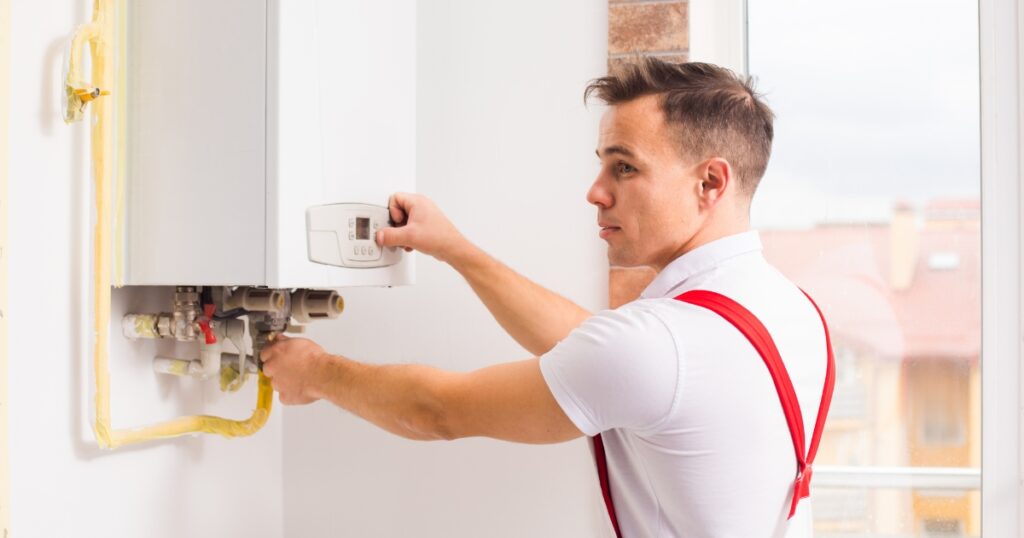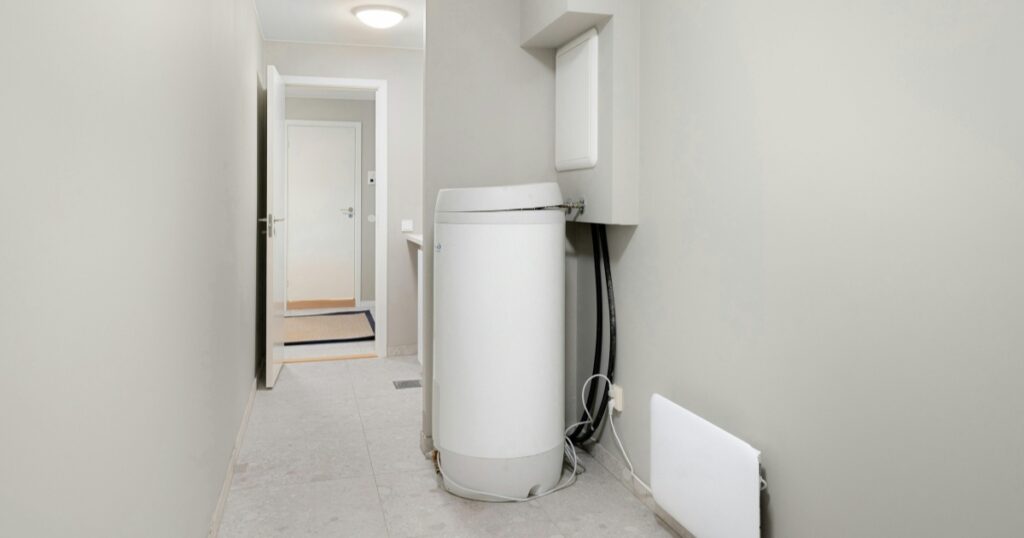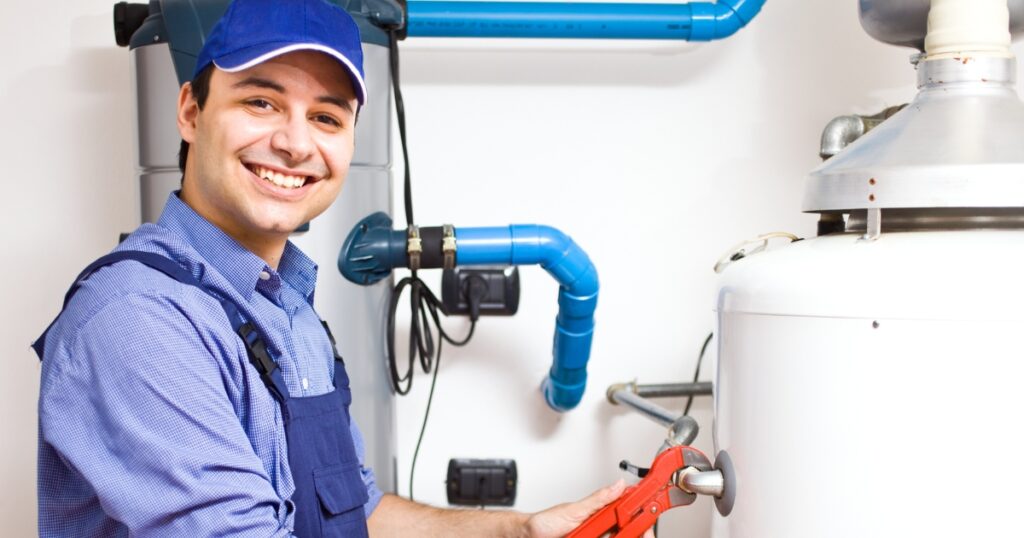Waking up to a cold shower isn’t exactly anyone’s idea of a good start to the day, now is it? We’ve felt that icy sting ourselves and have done the legwork to sort it out. In this yarn, we’ll pass on some hot tips for fixing your hot water service thermostat woes so you can get back to those warm, cosy showers.
Key Takeaways
- Check your hot water system regularly for signs of a faulty thermostat, such as cold water when you need hot or inconsistent temperatures.
- Carry out DIY troubleshooting by checking the power supply, resetting the high-temperature cutoff switch, and cleaning the inside of your hot water system to solve common problems.
- Understand that issues like damaged heating elements, sediment buildup in the tank, and improper installation can lead to thermostat malfunctions requiring professional attention.
- Maintain your hot water system with regular inspections and cleanings to prevent sediment buildup and ensure efficient performance. This includes flushing the tank and testing the water pressure.
- Seek help from professional repair services when facing persistent problems with your thermostat or if unsure about doing repairs yourself. Professionals offer expertise and guarantees for their work which can save time and money in the long run.
Signs of a Faulty Hot Water Service System Thermostat
If your hot water is running cold all the time, it might be a sign of a faulty thermostat. Not having any hot water when you should is another indicator that there may be an issue with the thermostat.
Cold water all the time
We often hear from homeowners struggling with their hot water systems, specifically when they only get cold water out of the taps. This frustrating issue is usually a sign that something’s not right with the thermostat.
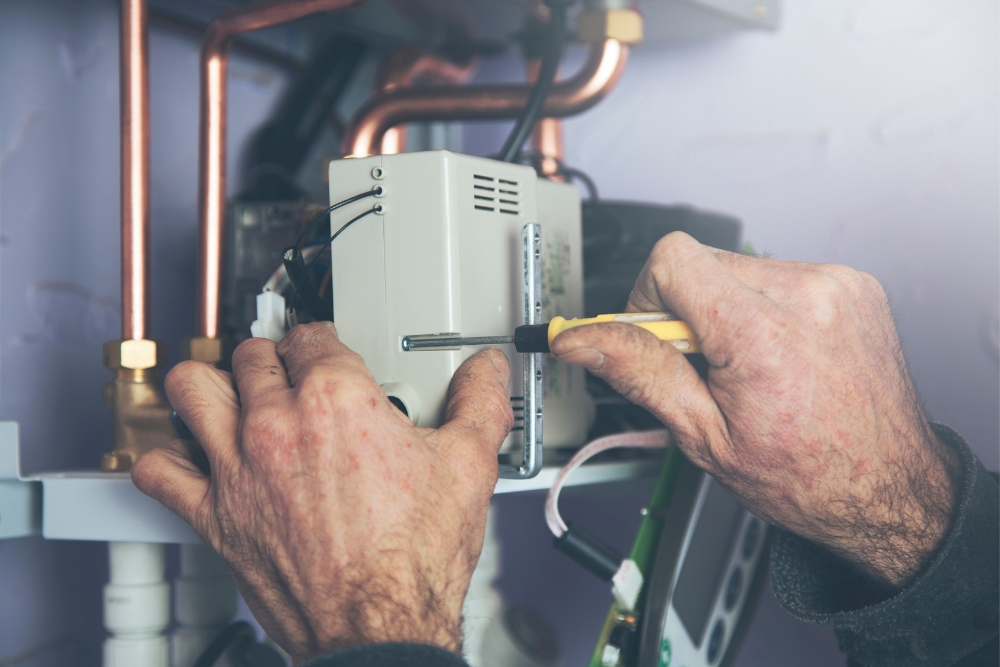
The thermostat plays a crucial role in regulating water temperature, but if it malfunctions or fails entirely, it won’t signal the heating element to warm up the water.
A faulty heating element or sediment buildup in the tank might also be causing your hot water service to underperform, leading you to face cold showers daily. Troubleshooting these problems involves checking for tripped circuit breakers and ensuring there are no blown fuses.
It’s essential to address these issues promptly to avoid further damage and inconvenience.
No hot water
If your hot water system isn’t providing any hot water, it could be due to a tripped circuit breaker or a malfunctioning thermostat. A faulty heating element or an accumulation of sediment in the tank might also cause this issue.
It’s crucial to check for blown fuses, ensure that the thermostat is functioning properly, and reset the high-temperature cut-off switch if it has tripped. Additionally, if there are any concerns about dangerously high temperatures without warning, it’s essential to address the problem promptly.
To resolve this issue, consider checking the power supply and inspecting both the thermostat settings and functionality. It is important to identify any faults with the heating element and clean out any sediment buildup within your hot water system.
Inconsistent water temperature
To avoid inconsistent water temperature in your hot water system, it’s crucial to address potential issues such as a faulty thermostat or a damaged heating element. Sediment buildup in the tank can also lead to uneven heating, causing fluctuations in water temperature.
Regular inspections and cleaning of the tank can prevent sediment from affecting your water temperature control. Additionally, testing the water pressure and ensuring proper thermostat calibration is essential for maintaining a consistent hot water supply throughout your home.
Ensuring that both the thermostat and heating element function properly is key to preventing inconsistent water temperatures. Flushing the tank and regular maintenance checks will help maintain optimal performance from your hot water system while minimising any disruptions due to fluctuating temperatures.
Common Causes of Hot Water System Thermostat Problems
Faulty thermostat wiring can disrupt the communication between the heating element and the temperature control, leading to irregular water temperatures. Sediment buildup inside the hot water tank may cause the thermostat to inaccurately sense water temperature, resulting in inconsistent performance.
Damaged heating element
A damaged heating element can lead to a lack of hot water in your home. Sediment buildup in the water tank or a fault in the thermostat can contribute to this issue as well. When the heating element is damaged, it may cause inconsistent water temperatures or no hot water at all.
Regular inspections and cleaning, along with testing the functionality of the heating element, are essential for preventing these issues from occurring.
To avoid dangerous situations such as overheating without warning, it’s crucial to promptly address any problems related to the heating element within your hot water system. If you suspect damage to the heating element, it’s best to contact a professional repair service specialising in hot water system maintenance and repairs for assistance.
Water leak
If you notice a water leak around your hot water system, it could be a sign of a serious problem that needs immediate attention. A leaking hot water system can result from issues such as corrosion, loose connections, or high water pressure within the unit.
This can lead to property damage and potential health hazards due to mould growth and electrical malfunctions. It’s essential to address a water leak promptly to prevent further damage and ensure the safety of your home.
Regular inspections and maintenance, including checking for leaks and addressing them early on, are critical in preventing more significant problems with your hot water system down the line.
Improper installation
Improper installation of a hot water system can lead to various thermostat problems. It may result in the thermostat not being positioned correctly, causing inaccurate temperature readings and possible malfunctions.
The wiring also needs to be installed properly as any faults in the connections could affect the functionality of the thermostat and overall hot water system performance.
Faulty installations can also lead to leaks within the system, affecting its efficiency and potentially damaging other components. With improper installation, issues such as gas or water leaks might occur, leading to safety concerns and potential hazards for your home’s occupants.
Faulty pilot light
If you’ve checked for issues related to improper installation and are still experiencing problems with your hot water system, a faulty pilot light could be the culprit. A pilot light that won’t stay lit or is flickering could lead to the water not heating properly, resulting in no hot water in your home.
In some cases, a problematic pilot light can also trigger safety features, causing the entire system to shut down.
Natural gas leak
If you suspect a natural gas leak in your hot water system, evacuate the premises immediately and call the gas company or emergency services. Natural gas leaks can pose a serious safety hazard as they are highly flammable and can lead to carbon monoxide poisoning.
It’s important to act quickly if you smell sulphur or rotten eggs near your hot water system, hear hissing sounds, notice dead vegetation near the area, or experience symptoms like headaches and nausea.
A professional should inspect and repair the leak to ensure the safety of your home.
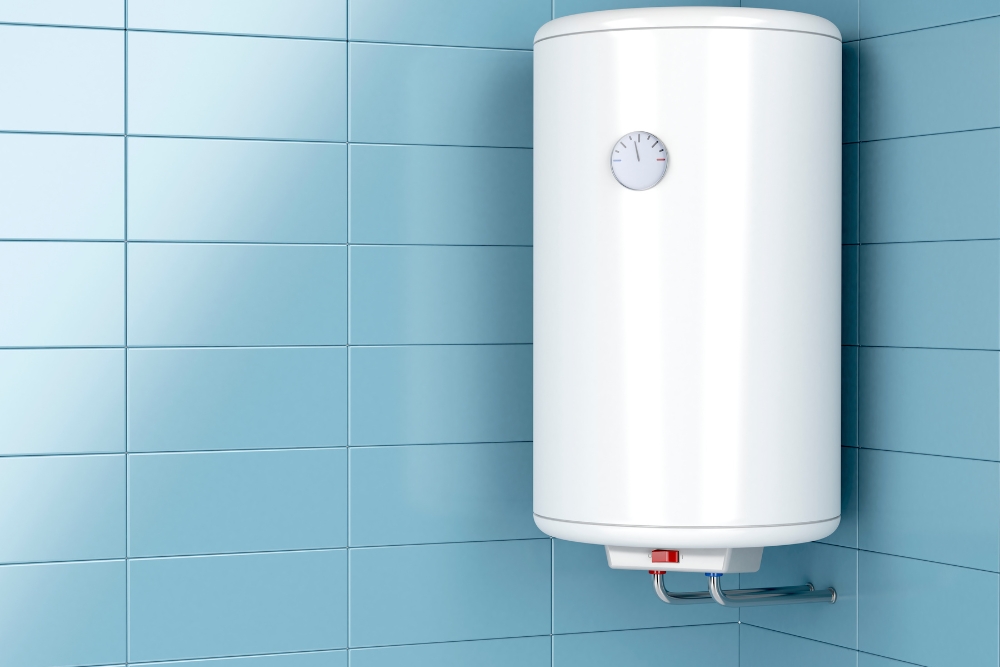
DIY Troubleshooting Tips
Check the power supply to the hot water system and ensure it is connected properly. Reset the high-temperature cut-off switch if there has been a power outage or surge.
Checking power supply
To check the power supply, start by ensuring that the hot water system is receiving electricity. Look for blown fuses or tripped circuit breakers in the electrical panel. If any are found, replace the fuse or reset the breaker to restore power to the water heater.
Inspect the wiring and connections for any signs of damage. Use a multimeter to test if there is voltage reaching the thermostat and heating element, as this can help identify electrical issues causing dysfunction in your hot water service.
If you suspect an issue with your hot water system’s power supply, it may be necessary to seek professional assistance from an electrician specialising in this area. Keep in mind that handling electricity can be hazardous and should always be approached with caution.
Resetting the high-temperature cut-off switch
The high-temperature cut-off switch can trip if the water inside the tank gets too hot, shutting off the power to prevent overheating. To reset it, locate the red button on the thermostat and press it firmly.
This action restores power to your hot water system and may resolve issues with no hot water.
If you have a gas hot water system, ensure that the pilot light is lit after resetting the high-temperature cut-off switch. For electric systems, check if there’s warm or hot water flowing from your taps after resetting.
Checking thermostat settings
To check thermostat settings, first locate the thermostat on your hot water system. Ensure it is set to the appropriate temperature, usually between 120-140 degrees Fahrenheit. Use a thermometer to verify that the water temperature matches the setting.
If not, you may need to adjust it by turning the dial or following manufacturer instructions for digital thermostats. In case of any issues with adjustment or inconsistency in temperature, consider contacting a professional service for further assessment.
If needed, call in an expert plumber to inspect and calibrate your thermostat accurately as per safety standards and to ensure the efficient functioning of your hot water system.
Replacing damaged parts
If you suspect that a damaged part is causing issues with your hot water system, it’s essential to take action promptly. First, turn off the power supply to the hot water service before inspecting and replacing any damaged components.
The heating element is a common culprit for malfunctioning thermostats, so check and replace this part if necessary. Additionally, inspect the thermostat settings and wires for any visible damage or wear.
If the wiring or thermostat appears faulty, replacing these parts can often resolve the problem without much hassle.
Cleaning inside of hot water system
To ensure your hot water system functions optimally, regular cleaning inside the tank is essential. Sediment buildup can hinder its efficiency and cause slow heating, leading to frustration for users.
Neglecting this maintenance task could result in a malfunctioning thermostat or even potential safety hazards due to dangerously high water temperatures. Cleaning the inside of the hot water system involves flushing the tank and removing any sediment that has accumulated over time.
Regular cleanings help maintain proper functionality and prevent issues with your hot water service, ensuring a steady supply of hot water when needed. This simple maintenance task can extend the lifespan of your hot water system and keep it running smoothly for years to come.
Professional Repair Services
When encountering persistent issues with your hot water system, it’s advisable to seek professional repair services for a thorough diagnosis and efficient resolution. Expert technicians can accurately identify the underlying problems and offer cost-effective solutions tailored to your specific needs.
When to call a professional
If you experience any of these issues with your hot water system, such as no hot water, inconsistent water temperature, or unusual noises coming from the unit, it’s time to call a professional.
A malfunctioning thermostat or heating element could be causing these problems. It’s best to seek the expertise of a qualified technician who can diagnose and repair the issue correctly.
Additionally, attempting DIY repairs for electrical and plumbing systems may pose safety risks and can void warranty coverage.
Benefits of professional repair
Professional repair services offer several benefits for homeowners facing hot water system thermostat issues. An experienced technician can accurately diagnose the problem, ensuring that the underlying issue is effectively resolved.
This expertise minimises the likelihood of further problems arising in the near future, providing long-term peace of mind.
Furthermore, professional repair services come with a warranty and guarantee, offering homeowners protection and assurance that their hot water system will be efficiently fixed. Moreover, by engaging a professional for repairs, homeowners can avoid potential safety hazards associated with DIY fixes.
Cost comparison with DIY repairs
Following the insights on the benefits of professional repair, it’s crucial we delve into the cost comparison with DIY repairs. This comparison can help us make informed decisions about whether to tackle the hot water system issues ourselves or call in the professionals.
| Aspect | DIY Repair Costs | Professional Repair Costs |
|---|---|---|
| Parts | Price of individual parts only | Parts + Markup |
| Labour | Free (Your own time) | Hourly rate of technician |
| Tools | Possibly need to buy | Included in service |
| Expertise | Limited | Specialised knowledge and skills |
| Risk | Potential for costly mistakes | Insured and guaranteed work |
| Time | The price of individual parts only | Typically quicker and more efficient |
Choosing between DIY and professional repairs involves weighing the upfront costs against the long-term benefits and risks. While DIY can appear less expensive initially, the potential for mistakes and the time investment can outweigh the costs of hiring a professional, who brings expertise, efficiency, and guarantees.
Preventative Maintenance for Your Hot Water System
To keep your hot water system in top shape, regular inspections and cleaning are essential. Flushing the tank and testing water pressure can help maintain efficient performance and prevent potential issues.
For more tips on keeping your hot water system running smoothly, read on!
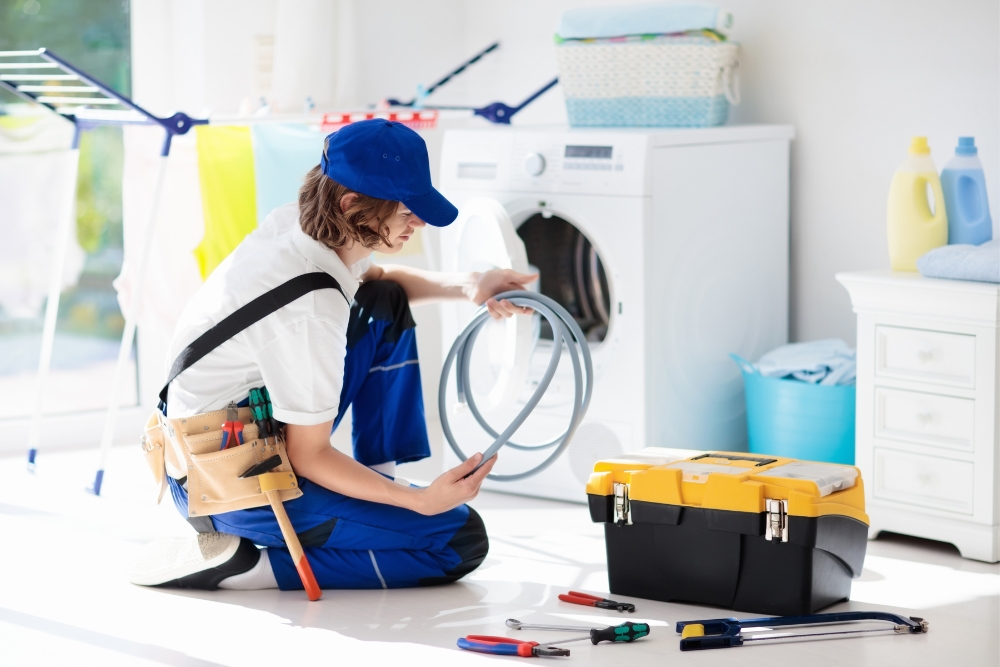
Regular inspections and cleaning
Regular inspections and cleaning of your hot water system are essential to ensure its optimal functioning. Sediment buildup in the tank can lead to slow heating, resulting in frustration for users.
Therefore, flushing the tank should be carried out at regular intervals to remove any accumulated sediment and maintain efficient water heating. It is also important to test the water pressure periodically as high pressure can put strain on the system, potentially causing damage.
Additionally, contacting a professional for routine inspections will help identify any potential issues early on and prevent costly repairs down the line.
Ensuring that your hot water system receives regular maintenance will contribute to its longevity and reliable performance. Professional services for inspection and cleaning provide expert evaluation of your system’s condition while offering thorough cleaning solutions that effectively remove sediment build-up from the tank, keeping it running smoothly.
Flushing the tank
To maintain the efficiency of your hot water system, regularly flushing the tank is crucial. Sediment buildup in the tank can slow down the heating process and affect the overall functioning of the system.
Flushing helps to remove sediment and debris, allowing for better heat transfer which in turn improves energy efficiency. It is important to rely on professional maintenance services or follow the manufacturer’s guidelines when performing this task to ensure that it is done correctly.
By flushing the tank, you can prevent a build-up of sediment which contributes to slow-heating water systems. This will help maintain an effective hot water service and prolong its lifespan.
Testing water pressure
To ensure the efficient functioning of your hot water system, it’s essential to regularly test the water pressure. High or low water pressure can lead to issues with your thermostat, heating element, and overall performance of the hot water service.
Testing the water pressure involves using a simple gauge which can be purchased at most hardware stores. Attach the gauge to an outdoor faucet and turn on the water to get an accurate reading.
The recommended range for residential homes is typically between 40-60 psi, so if you find that your water pressure falls outside this range, it may be affecting your hot water system.
Contacting a professional for replacement
If you’re experiencing persistent issues with your hot water system despite attempting DIY troubleshooting, it may be time to contact a professional for replacement of the thermostat or other faulty components.
A trained technician can assess the situation and determine if a replacement is necessary based on factors such as the age and condition of the system. Professional repair services can also ensure that all safety measures are taken into account when replacing components, providing peace of mind for homeowners.
Replacement for malfunctioning parts is best handled by a professional due to their expertise in identifying underlying problems and ensuring proper installation. When dealing with hot water system concerns, seeking professional assistance guarantees an accurate diagnosis and appropriate solution, promoting efficient performance and longevity of the unit.
Fast and Effective Hot Water Repairs in Your Area!
To fix hot water service thermostat problems, identify signs of a faulty system. Check for consistent water temperature and cold or no hot water issues. Troubleshoot the thermostat by examining the power supply, resetting the high-temperature cut-off switch, and cleaning inside the hot water system.
Consider professional repair services when needed for proper maintenance of your hot water system.
Are you struggling with hot water service thermostat issues? Let Hot Water Repairs Today handle it with expertise and precision.
Our team specialises in diagnosing and resolving problems related to hot water service thermostats. Whether it’s a malfunctioning thermostat, inaccurate temperature settings, or any other issue affecting your hot water supply, we have the skills and knowledge to fix it promptly.
Don’t let thermostat problems disrupt your comfort and convenience. Trust Hot Water Repairs Today to deliver efficient solutions that restore your hot water system’s optimal performance. Contact us now to schedule a service and regain control over your hot water temperature.



